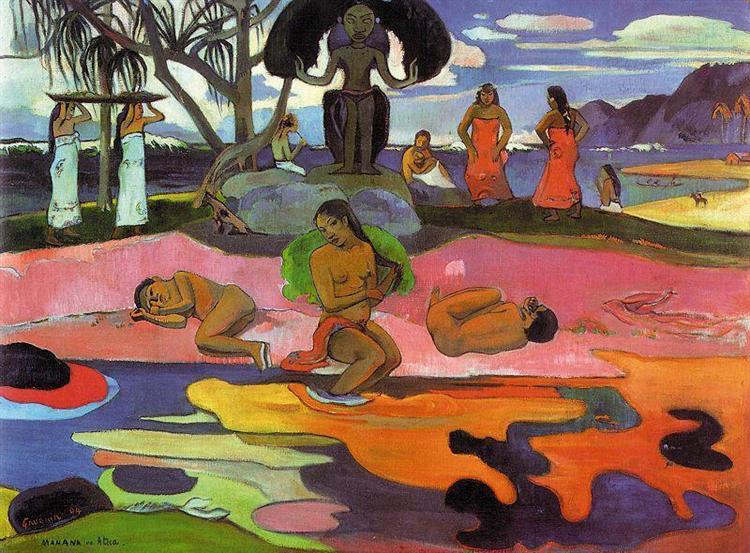Opis
Praca „Day of the Gods” (1894) autorstwa Paula Gauguina stanowi znaczący kamień milowy w ewolucji współczesnego malarstwa, wyróżniającym się z odważnego używania kolorów i eksploracji głębokich rdzennych problemów. Rozważając ten utwór, przedstawiono nam świat, w którym mitologia i rzeczywistość są powiązane z niemal namacalną intensywnością. Gauguin, który pozostawił konwencje sztuki europejskiej, aby zanurzyć się w życiu i kulturze Tahiti, szuka w tej pracy, aby przekroczyć jedynie wizualne i otworzyć próg w kierunku bogatego doświadczenia duchowego i kulturowego.
Zastosowanie koloru w „Dzień Boga” jest szczególnie fascynujące. Gauguin odchodzi od naturalistycznej reprezentacji, wybierając żywą paletę, która nasila emocje obrazu. Niebieskie i zielone odcienie dominują w krajobrazie, podczas gdy czerwone, żółte i ochra zapewniają energię witokresową ludzkim postaciom i elementom środowiska. To chromatyczne podejście nie tylko rejestruje esencję Tropików Tahitian, ale także rezonuje z emocjonalną symboliką, która zaprasza widzów do doświadczenia trzewnej reakcji na dzieło.
Kompozycja stanowi niezwykłą równowagę między liczbami a krajobrazem. W środkowej części Gauguin zawiera trzy postacie żeńskie, które wydają się być owinięte w niemym, wielowymiarowe i ponadczasowe dialog. Jego obecność sugeruje powiązania z bogami lub przodkami, co zachęca do refleksji na temat czasu, kultury i tożsamości. W szczególności postać po prawej zawiera obiekt, którego znaczenie wymyka się prostą interpretację, obejmując złożoność duchowości tahitańskiej i jej związek ze światem przyrody.
Tło farby nie ogranicza się tylko do bycia dekoracyjnym; W swojej konstrukcji Gauguin integruje góry i morze, reprezentując symboliczne elementy, które często pojawiają się w ich pracy. Góry, z ich solidnymi liniami i morzem, w niepokojącym spokoju, konfigurują tło, które dodatkowo podkreśla duchowe doświadczenie, które artysta stara się przekazać. Chmury, w łagodnym kolorze, dodają również element introspekcji, sugerując związek między niebem a ziemią.
Praca odzwierciedla także poszukiwanie Gauguina poczucia oryginału, chęć połączenia się z prawdziwym, nie zanieczyszczonym przez europejską nowoczesność. Zainteresowanie kulturą tubylczą objawia się nie tylko wyborem przedmiotów, ale także twórczą interpretacją tradycji. „Day of the Gods” daje nam zatem spojrzenie na duchowość tahitowską, dziedzictwo, które, choć wynikające z obserwacji, rozwija się w osobistym stylu, który sprzeciwia się pojęciu dokładnego reprezentacji.
Razem „Day of the Gods” to dzieło, które zachęca do szerokiego spektrum interpretacji, od podniesienia życia codziennego po bosce, po komentarz na temat związku między człowiekiem a naturą. Praca zawiera podróż Gauguina do języka wizualnego, który, choć zakotwiczony w reprezentacji jego czasów, rezonuje z uniwersalnością, która pozostaje aktualna. Doceniając ten obraz, przypomina nam się zdolność sztuki do przekroczenia chwili, oferując licznik ludzkiego doświadczenia, które trwa poza ograniczeniami czasu i kultury. Symboliczne i emocjonalne bogactwo „Dnia Bożego” nadal rezonuje, rzucając wyzwanie każdemu widzowi do głębokiego dialogu z pracą i jego kontekstem.
KUADROS ©, słynna farba na ścianie.
Ręcznie wykonane obrazy olejne, z jakością profesjonalnych artystów i charakterystyczną pieczęcią KUADROS ©.
Usługa reprodukcji zdjęć z gwarancją satysfakcji. Jeśli nie jesteś w pełni zadowolony z repliki twojego obrazu, zwrócimy twoje pieniądze w 100%.

